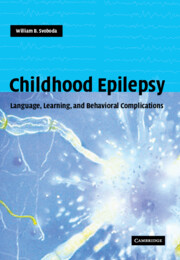Book contents
- Frontmatter
- Contents
- Preface
- Glossary
- 1 Looking ahead
- Part I Speech and language problems
- 2 Language: the challenge
- 3 Speech, language, and communication
- 4 Speech and language problems in epilepsy
- 5 Seizure types and speech and language risks
- 6 Language regression with epilepsy syndromes
- 7 Other epilepsy language syndromes
- 8 Seizure-management effects
- 9 Evaluation of speech and language problems
- 10 Management of speech and language problems in epilepsy
- 11 Behavior consequences
- Part II Learning problems
- Part III Behavior problems
- Index
- References
8 - Seizure-management effects
from Part I - Speech and language problems
Published online by Cambridge University Press: 26 October 2009
- Frontmatter
- Contents
- Preface
- Glossary
- 1 Looking ahead
- Part I Speech and language problems
- 2 Language: the challenge
- 3 Speech, language, and communication
- 4 Speech and language problems in epilepsy
- 5 Seizure types and speech and language risks
- 6 Language regression with epilepsy syndromes
- 7 Other epilepsy language syndromes
- 8 Seizure-management effects
- 9 Evaluation of speech and language problems
- 10 Management of speech and language problems in epilepsy
- 11 Behavior consequences
- Part II Learning problems
- Part III Behavior problems
- Index
- References
Summary
Hippocrates warned, “What is one man's pleasure is another man's poison.” This can be applied to antiepileptic drugs. What helps one patient may do nothing for a second patient and may produce undesirable side effects in a third patient.
Antiepileptic drug helps and hindrances
Pharmacologic principles
An antiepileptic drug does not affect only a specific brain site and a specific function. Rather, it affects the entire brain and many functions. Some basic principles help in understanding these effects.
Some seizures are due to excessive discharges of parts of the brain, as with partial seizures. Some seizures are due to bursts of inhibition from deeper portions of the brain, as with absence, myoclonic, and atonic seizures. With focal discharge, enlargement of the discharge area and the spread to involve distant sites are important.
Inhibiting excessive excitation and vice versa
Anticonvulsants act by inhibiting excess discharges, by provoking excessive inhibition, or by stopping the discharge spread. The actions of the brain are mediated by neurotransmitters. There are inhibitory neurotransmitters and excitatory neurotransmitters. Antiepileptic drugs tend to mimic the neurotransmitters, block the neurotransmitter actions, facilitate the production of neurotransmitters or inhibit the breakdown and removal of them.
Stopping the focus, enlargement, and spread
Antiepileptic action may be to inhibit a focus from firing, to limit the focus from becoming large enough to produce a seizure, or to limit the spread from the focus to other parts of the brain.
- Type
- Chapter
- Information
- Childhood EpilepsyLanguage, Learning and Behavioural Complications, pp. 116 - 132Publisher: Cambridge University PressPrint publication year: 2004



